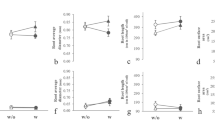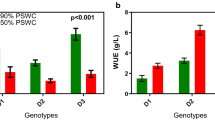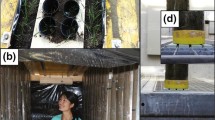Abstract
Main conclusion
Primitive wheat follows an opposite metabolic law from modern wheat with regard to leaf biomass/reproductive growth vs above-ground biomass that is under the regulation of non-hydraulic root signals and that influences resource acquisition and utilization.
Abstract
Non-hydraulic root signals (nHRS) are so far affirmed as a unique positive response to drying soil in wheat, and may imply huge differences in energy metabolism and source–sink relationships between primitive and modern wheat species. Using a pot-culture split-root technique to induce nHRS, four primitive wheat genotypes (two diploids and two tetraploids) and four modern wheat ones (released from different breeding decades) were compared to address the above issue. The nHRS was continuously induced in drying soil, ensuring the operation of energy metabolism under the influence of nHRS. We found that primitive wheat followed an opposite size-dependent allometric pattern (logy = αlogx + logβ) in comparison with modern wheat. The relationships between ear biomass (y-axis) vs above-ground biomass (x-axis), and between reproductive biomass (y-axis) and vegetative (x-axis) biomass fell into a typical allometric pattern in primitive wheat (α > 1), and the nHRS significantly increased α (P < 0.01). However, in modern wheat, they turned to be in an isometric pattern (α ≈ 1). Regardless of nHRS, either leaf (i.e., metabolic rate) or stem biomass generally exhibited an isometric relationship with above-ground biomass in primitive wheat (α ≈ 1), while in modern wheat they fell into an allometric pattern (α > 1). Allometric scaling of specific leaf area (SLA) or biomass density showed superior capabilities of resource acquisition and utilization in modern wheat over primitive ones. We therefore proposed a generalized model to reveal how modern wheat possesses the pronounced population yield advantage over primitive wheat, and its implications on wheat domestication.





Similar content being viewed by others
Abbreviations
- ABA:
-
Abscisic acid
- ANOVA:
-
Analysis of variance
- CK:
-
Control group
- W d :
-
Dry weight
- W f :
-
Fresh weight
- HI:
-
Harvest index
- g s :
-
Leaf stomatal conductance
- LSD:
-
Least significant difference
- nHRS:
-
Non-hydraulic root signals
- PC:
-
Pot capacity
- RWC:
-
Relative water content
- SLA:
-
Specific leaf area
- W t :
-
Turgid weight
- WUE:
-
Water use efficiency for grain
References
Araus JL, Ferrio JP, Buxó R, Voltas J (2007) The historical perspective of dryland agriculture: lessons learned from 10,000 years of wheat cultivation. J Exp Bot 58(2):131–145. https://doi.org/10.1093/jxb/erl133
Austin RB, Morgan CL, Ford MA, Bhagwat SG (1982) Flag leaf photosynthesis of Triticum aestivum and related diploid and tetraploid species. Ann Bot 49(2):177–189. https://doi.org/10.1093/oxfordjournals.aob.a086238
Austin RB, Morgan CL, Ford MA (1986) Dry matter yields and photosynthetic rates of diploid and hexaploid triticum species. Ann Bot 57(6):847–857. https://doi.org/10.1093/oxfordjournals.aob.a087169
Batool A, Aisha N, Cheng Z, Lv G, Ashraf M, Afzal M, Xiong J, Wang J, Xiong Y (2019) Physiological and biochemical responses of two spring wheat genotypes to non-hydraulic root-to-shoot signalling of partial and full root-zone drought stress. Plant Physiol Bioch 139:11–20. https://doi.org/10.1016/j.plaphy.2019.03.001
Blackman PG, Davies WJ (1985) Root to shoot communication in maize plants of the effects of soil drying. J Exp Bot 36(1):39–48. https://doi.org/10.1093/jxb/36.1.39
Cock AG (1966) Genetical aspects of metrical growth and form in animals. Q Rev Biol 41(2):131–190. https://doi.org/10.1086/404940
Coleman JS, McConnaughay KDM, Ackerly DD (1994) Interpreting phenotypic variation in plants. Trends Ecol Evol 9(5):187–191. https://doi.org/10.1016/0169-5347(94)90087-6
Davies WJ, Tardieu F, Carlos LT (1994) How do chemical signals work in plants that grow in drying soil? Plant Physiol 104(2):309–314. https://doi.org/10.1104/pp.104.2.309
Dawkins R, Krebs JR (1979) Arms races between and within species. Proc R Soc Lond B Biol Sci 205(1161):489–511. https://doi.org/10.1098/rspb.1979.0081
Denison RF (2012) Darwinian agriculture: how understanding evolution can improve agriculture. Princeton University Press, Canberra. https://doi.org/10.1037/12294-002
Donald CM (1968) The breeding of crop ideotypes. Euphytica 17(3):385–403. https://doi.org/10.1007/bf00056241
Du YL, Wang ZY, Fan JW, Turner NC, Wang T, Li FM (2012) β-Aminobutyric acid increases abscisic acid accumulation and desiccation tolerance and decreases water use but fails to improve grain yield in two spring wheat cultivars under soil drying. J Exp Bot 63(13):4849–4860. https://doi.org/10.1093/jxb/ers164
Egset CK, Hansen TF, Rouzrc AL, Bolstad GH, Rostnqvist G, Pelabon C (2012) Artificial selection on allometry: change in elevation but not slope. J Evolution Biol 25:938–948. https://doi.org/10.1111/j.1420-9101.2012.02487.x
Ericsson T (1995) Growth and shoot: root ratio of seedlings in relation to nutrient availability. Plant Soil 168–169(1):205–214. https://doi.org/10.1007/bf00029330
Fan XW, Li FM, Song L, Xiong YC, Lz An, Jia Y, Fang XW (2009) Defense strategy of old and modern spring wheat varieties during soil drying. Physiol Plant 136(3):310–323. https://doi.org/10.1111/j.1399-3054.2009.01225.x
Gabor J, Jurriaan T, Victor F, Laurent Z, Jean P, Métraux Brigitte M-M (2005) Enhancing arabidopsis salt and drought stress tolerance by chemical priming for its abscisic acid responses. Plant Physiol 139(1):267–274. https://doi.org/10.1104/pp.105.065698
Gedroc JJ, McConnaughay KDM, Coleman JS (1996) Plasticity in root/shoot partitioning: optimal, ontogenetic, or both? Funct Ecol 10(1):44–50. https://doi.org/10.2307/2390260
Gersani M, Brown JS, O’Brien EE, Maina GM, Abramsky Z (2001) Tragedy of the commons as a result of root competition. J Ecol 89(4):660–669. https://doi.org/10.1046/j.0022-0477.2001.00609.x
Govindachary S, Bukhov NG, Joly D, Carpentier R (2004) Photosystem II inhibition by moderate light under low temperature in intact leaves of chilling -sensitive and -tolerant plants. Physiol Plant 121(2):322–333. https://doi.org/10.1111/j.0031-9317.2004.00305.x
Huang ML, Deng XP, Zhao YZ, Zhou SL, Inanaga S, Yamada S, Tanaka K (2007) Water and nutrient use efficiency in diploid, tetraploid and hexaploid wheats. J Integr Plant Biol 49(5):706–715. https://doi.org/10.1111/j.1744-7909.2007.00463.x
Huxley JS (1932) Problems of relative growth. Methuen & Co., London. https://doi.org/10.1093/aesa/25.4.757
Jones M, Turner N (1980) Osmotic adjustment in expanding and fully expanded leaves of sunflower in response to water deficits. Funct Plant Biol 7(2):181–192. https://doi.org/10.1071/PP9800181
Jurczyk B, Rapacz M, Pociecha E, Kościelniak J (2016) Changes in carbohydrates triggered by low temperature waterlogging modify photosynthetic acclimation to cold in Festuca pratensis. Environ Exp Bot 122:60–67. https://doi.org/10.1016/j.envexpbot.2015.09.003
Lenton JR, Hedden P, Gale MD (1987) Gibberellin insensitivity and development in wheat-consequences for development. Hormone action in plant development–acritical appraisal. Butterworth-Heinemann, Oxford, pp 145–160. https://doi.org/10.1016/b978-0-408-00796-2.50015-3
Murren CJ (2002) Phenotypic integration in plants. Plant Spec Biol 17(2–3):89–99. https://doi.org/10.1046/j.1442-1984.2002.00079.x
Pastori GM, Foyer CH (2002) Common components, networks, and pathways of cross-tolerance to stress. The central role of “redox” and abscisic acid-mediated controls. Plant Physiol 129(2):460–468. https://doi.org/10.1104/pp.011021
Qin XL, Weiner J, Qi L, Xiong YC, Li FM (2013) Allometric analysis of the effects of density on reproductive allocation and Harvest Index in 6 varieties of wheat (Triticum). Field Crops Res 144:162–166. https://doi.org/10.1016/j.fcr.2012.12.011
Shingleton AW, Frankino WA, Flatt T, Nijhout HF, Emlen DJ (2007) Size and shape: the developmental regulation of static allometry in insects. BioEssays 29(6):536–548. https://doi.org/10.1002/bies.20584
Turner NC (1981) Techniques and experimental approaches for the measurement of plant water status. Plant Soil 58(1):339–366. https://doi.org/10.1007/bf02180062
Turner NC (1996) Further progress in crop water relations. In: Donald LS (ed) Advances in agronomy, vol 58. Academic Press, Cambridge, pp 293–338. https://doi.org/10.1016/s0065-2113(08)60258-8
Turner NC (2018) Imposing and maintaining soil water deficits in drought studies in pots. Plant Soil. https://doi.org/10.1007/s11104-018-3893-1
Turner NC, Asseng S (2005) Productivity, sustainability, and rainfall-use efficiency in Australian rainfed Mediterranean agricultural systems. Aust J Agr Res 56(11):1123–1136. https://doi.org/10.1071/AR05076
Valkoun JJ (2001) Wheat pre-breeding using wild progenitors. Euphytica 119(1):17–23. https://doi.org/10.1023/a:1017562909881
Vallad GE, Goodman RM (2004) Systemic acquired resistance and induced systemic resistance in conventional agriculture. Crop Sci 44(6):1920–1934. https://doi.org/10.2135/cropsci2004.1920
Wang ZY, Li FM, Xiong YC, Xu BC (2008) Soil–water threshold range of chemical signals and drought tolerance was mediated by ROS homeostasis in winter wheat during progressive soil drying. J Plant Growth Regu 27(4):309. https://doi.org/10.1007/s00344-008-9057-4
Warton DI, Weber NC (2002) Common slope tests for bivariate errors-in-variables models. Biometrical J 44(2):161–174. https://doi.org/10.1002/1521-4036(200203)44:2%3c161:AID-BIMJ161%3e3.0.CO;2-N
Weiner J (1985) Size hierarchies in experimental populations of annual plants. Ecology 66(3):743–752. https://doi.org/10.2307/1940535
Weiner J (1988) The influence of competition on plant reproduction. In: Lovett-doust J, Lovett-doust L (eds) Patterns and strategies, vol 58. Oxford University Press, Oxford, pp 228–245. https://doi.org/10.1016/s0065-2113(08)60258-8
Weiner J, Fishman L (1994) Competition and allometry in kochia scoparia. Ann Bot 73(3):263–271. https://doi.org/10.1006/anbo.1994.1031
Weiner J, Solbrig OT (1984) The meaning and measurement of size hierarchies in plant populations. Oecologia 61(3):334–336. https://doi.org/10.2307/4217248
Weiner J, Rosenmeier L, Massoni ES, Vera JN, Plaza EH, Sebastià M-T (2009) Is reproductive allocation in Senecio vulgaris plastic? Botany 87(5):475–481. https://doi.org/10.1139/B09-012
Xiong YC, Li FM, Zhang T (2006) Performance of wheat crops with different chromosome ploidy: root-sourced signals, drought tolerance, and yield performance. Planta 224(3):710. https://doi.org/10.1007/s00425-006-0252-x
Zhang J, Davies WJ (1990) Changes in the concentration of ABA in xylem sap as a function of changing soil water status can account for changes in leaf conductance and growth. Plant Cell Environ 13(3):277–285. https://doi.org/10.1111/j.1365-3040.1990.tb01312.x
Acknowledgements
We would like to thank Prof. Neil C. Turner for his insightful comments on our manuscript. This work was supported by the Natural Science Foundation of China (31570415), State Technology Support Program (2015BAD22B04) and National Specialized Support Plan for Outstanding Talents (“Ten Thousand People Plan”).
Author information
Authors and Affiliations
Author notes
Guang-Chao Lv and Zheng-Guo Cheng equally contributed to this work.
Corresponding author
Additional information
Publisher's Note
Springer Nature remains neutral with regard to jurisdictional claims in published maps and institutional affiliations.
Rights and permissions
About this article
Cite this article
Lv, GC., Cheng, ZG., Li, FM. et al. Comparative response to drought in primitive and modern wheat: a cue on domestication. Planta 250, 629–642 (2019). https://doi.org/10.1007/s00425-019-03188-1
Received:
Accepted:
Published:
Issue Date:
DOI: https://doi.org/10.1007/s00425-019-03188-1




